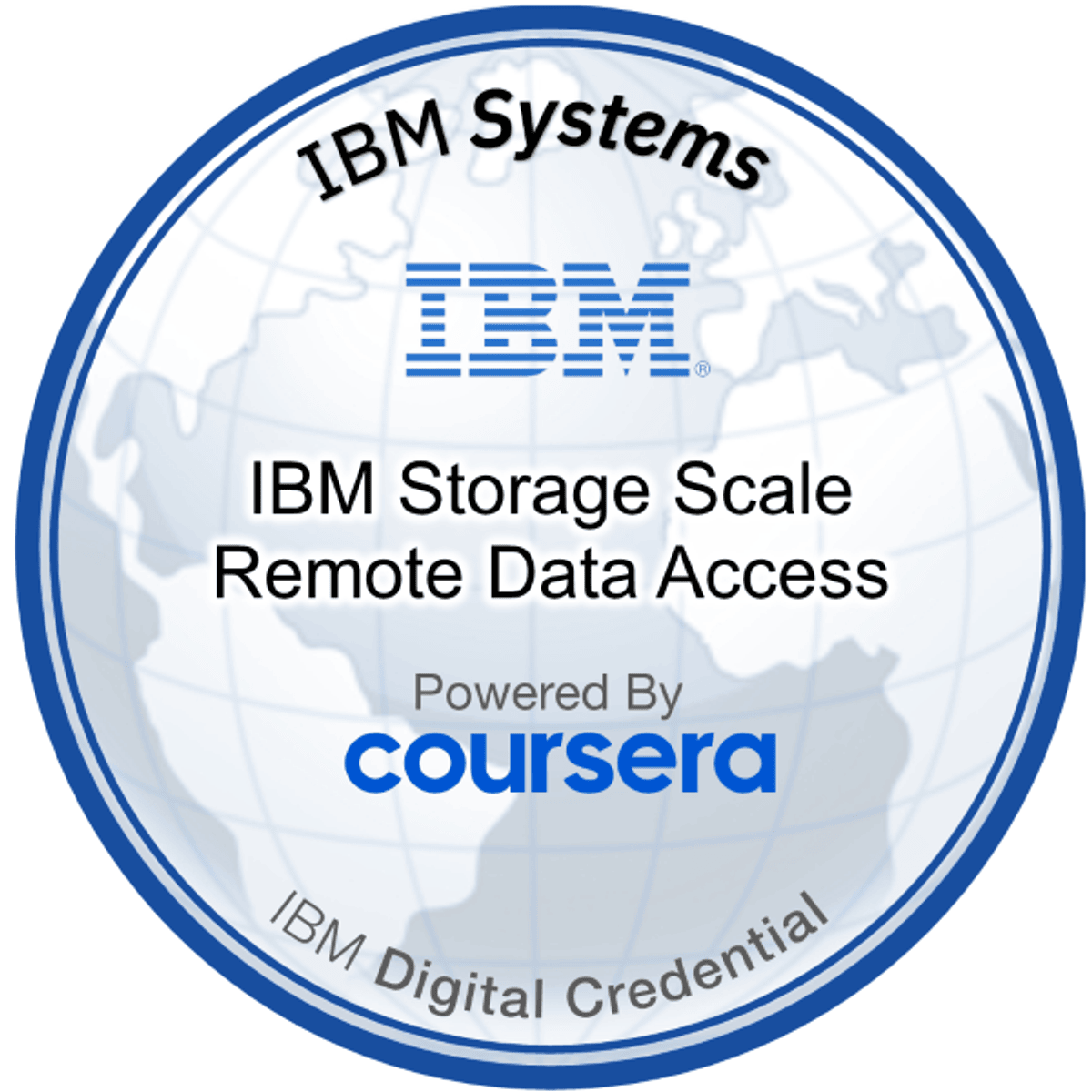
This course is intended for IT professionals tasked with administering a Storage Scale storage cluster consisting of Linux nodes. The course includes information on various Storage Scale features that enable remote access to data that is stored in a cluster file system. This includes: multi-cluster support, clustered NFS, cluster export services (CES) and protocol support (NFS, SMB, and Object), Active File Management (AFM), and AFM-based Asynchronous Disaster Recovery (AFM DR). The features are described in lecture materials and implemented in lab exercises.
What's inside
Syllabus
Introduction
Welcome to IBM Storage Scale: Remote Data Access. Please complete the reading to understand the purpose and audience for this course.
Read more
Syllabus
Good to know
Save this course
Activities
Review Linux command line basics
Show steps
Reinforce your foundational understanding of the Linux command line to enhance your overall experience with Storage Scale, which operates in a Linux environment.
Browse courses on
Linux
Show steps
-
Visit online resources or tutorials on Linux command line
-
Practice basic commands in a terminal window
Review Storage Scale documentation
Show steps
Review official course materials to refresh knowledge on topics covered in IBM Storage Scale: Remote Data Access.
Show steps
-
Access IBM documentation website
-
Locate Storage Scale documentation
-
Read through relevant sections and articles
Write a summary of Cluster Export Services (CES) features
Show steps
Solidify your comprehension of Cluster Export Services (CES) in Storage Scale by summarizing its key features and how they enhance data access.
Show steps
-
Review CES documentation and articles
-
Note down the main features and benefits of CES
-
Write a concise summary of your findings
Three other activities
Expand to see all activities and additional details
Show all six activities
Walkthrough of Storage Scale Active File Management (AFM)
Show steps
Explore Storage Scale's Active File Management (AFM) feature by following guided tutorials and enhance your understanding of file management.
Show steps
-
Find online tutorials on Storage Scale AFM
-
Watch the tutorials and take notes
-
Apply what you learned in a lab environment
Configure NFS and SMB shares
Show steps
Reinforce your understanding of NFS and SMB share configuration in Storage Scale through hands-on practice.
Browse courses on
NFS
Show steps
-
Create a Linux virtual machine or use existing one
-
Install Storage Scale software
-
Configure NFS and SMB shares
-
Mount and access shares from client machines
Build a simple Storage Scale cluster with multi-cluster support
Show steps
Extend your practical skills by building a basic Storage Scale cluster with multi-cluster support, solidifying your understanding of cluster management.
Show steps
-
Gather necessary hardware resources (servers, storage)
-
Install and configure Storage Scale software
-
Create multiple clusters and establish cross-cluster connections
-
Test data access and file sharing across clusters
Review Linux command line basics
Show steps
Reinforce your foundational understanding of the Linux command line to enhance your overall experience with Storage Scale, which operates in a Linux environment.
Browse courses on
Linux
Show steps
- Visit online resources or tutorials on Linux command line
- Practice basic commands in a terminal window
Review Storage Scale documentation
Show steps
Review official course materials to refresh knowledge on topics covered in IBM Storage Scale: Remote Data Access.
Show steps
- Access IBM documentation website
- Locate Storage Scale documentation
- Read through relevant sections and articles
Write a summary of Cluster Export Services (CES) features
Show steps
Solidify your comprehension of Cluster Export Services (CES) in Storage Scale by summarizing its key features and how they enhance data access.
Show steps
- Review CES documentation and articles
- Note down the main features and benefits of CES
- Write a concise summary of your findings
Walkthrough of Storage Scale Active File Management (AFM)
Show steps
Explore Storage Scale's Active File Management (AFM) feature by following guided tutorials and enhance your understanding of file management.
Show steps
- Find online tutorials on Storage Scale AFM
- Watch the tutorials and take notes
- Apply what you learned in a lab environment
Configure NFS and SMB shares
Show steps
Reinforce your understanding of NFS and SMB share configuration in Storage Scale through hands-on practice.
Browse courses on
NFS
Show steps
- Create a Linux virtual machine or use existing one
- Install Storage Scale software
- Configure NFS and SMB shares
- Mount and access shares from client machines
Build a simple Storage Scale cluster with multi-cluster support
Show steps
Extend your practical skills by building a basic Storage Scale cluster with multi-cluster support, solidifying your understanding of cluster management.
Show steps
- Gather necessary hardware resources (servers, storage)
- Install and configure Storage Scale software
- Create multiple clusters and establish cross-cluster connections
- Test data access and file sharing across clusters
Career center
Reading list
Share
Similar courses
OpenCourser helps millions of learners each year. People visit us to learn workspace skills, ace their exams, and nurture their curiosity.
Our extensive catalog contains over 50,000 courses and twice as many books. Browse by search, by topic, or even by career interests. We'll match you to the right resources quickly.
Find this site helpful? Tell a friend about us.
We're supported by our community of learners. When you purchase or subscribe to courses and programs or purchase books, we may earn a commission from our partners.
Your purchases help us maintain our catalog and keep our servers humming without ads.
Thank you for supporting OpenCourser.



